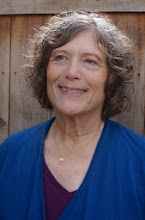Last
week, we served Yerba Buena Tea to attendees at the Heirloom Expo in Santa Rosa,
and I was impressed anew by the subtly pleasing qualities of this easy-to-make
tea from the California native groundcover called Satureja douglasii. This
wonderful little plant from the mint family grows under oak trees, where it is
said to be difficult to find plants that survive, especially if you follow the
rule to avoid watering out of season under oak trees. This rule is important
because some diseases attacking oaks come from the unCalifornian combination of
moisture and heat, which is not normally occurring in a Mediterranean climate
like ours in California. Actually, I think it's easy to garden or plant under
oak trees, but that's another topic.
Yerba
buena also can be found thriving at the edge of chaparral and coastal scrub,
making a lovely neat chartreuse edging along paths and trails. In the early
days of our 30-year-old Larner Seeds Demonstration Garden in Bolinas, I couldn't
get yerba buena to do well. Now that "things," and by "things," I mean the many
qualities of shade and sun and soil that have developed through the years, have
changed, it takes off and seems to do well everywhere we put it, except where
outcompeted by native blackberry.
So
I have lots of material for tea-making. For a crowd, I use approximately two
masses or clumps of stems and leaves that would fit in both my hands to make a
4-quart stockpot full of tea. This is always a matter of taste, but I prefer it
rather mild. Rinse it off and remove oak leaves that seem to always be caught in
it and pour boiling water over it. Let soak for ten or fifteen minutes. I've
also let it soak for a very long time, up to 12 hours, to make a concentrate,
such as for bringing to the Expo. Once there, I diluted the one quart of
concentrate with two to four gallons of filtered water. I also like to put some
sprigs of yerba buena into my drinking water at the beginning of a
hike.
It
is so refreshing in its mild way, having nothing to do with caffeine, and it
seemed to be greatly appreciated by thirsty Expo-goers. One sampler called it
"amazingly hydrating." When frequently asked about its medicinal qualities,
since it seems we can't be bothered drinking something without a confirmed
health benefit, I repeated the simple instructions given us by Milton "Bun"
Lucas, Pomo Indian, who is no longer with us, but who left many of us with
treasured information. Bun said that he saved it for special occasions so as to
retain its efficacy, using it for colds, or, as at the Expo, for times of
unusual demands, which could describe a fair of 20,000 people. That was the
pre-estimated number, though I, of course, didn't serve yerba buena tea to that
many people.
But
I almost could have.






No comments:
Post a Comment